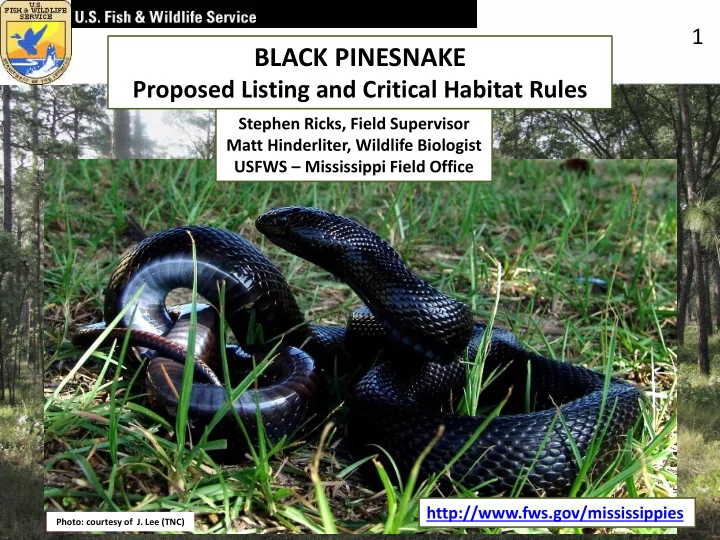

1 BLACK PINESNAKE Proposed Listing and Critical Habitat Rules Stephen Ricks, Field Supervisor Matt Hinderliter, Wildlife Biologist USFWS – Mississippi Field Office http://www.fws.gov/mississippies Photo: courtesy of J. Lee (TNC)
2 AGENDA Black pinesnake species description, habitat, and range Proposed listing rule Threats analysis Proposed exemptions authorized under Section 4(d) Proposed critical habitat rule How, why, and where units were selected Draft economic analysis Frequently asked questions Your questions
3 TIMELINE Federal Actions for the Black Pinesnake March 11, 2015 Proposed critical habitat rule May 11, 2015 October published; draft December Comment 1999 Fall 2015 October 7, 2014 economic 8, 2014 period closes Species Final rule Proposed listing analysis Comment for both placed on determinations rule published released; and period proposed candidate expected comment period closes rules list re-opened for proposed listing rule
4 BLACK PINESNAKE SPECIES DESCRIPTION Photos: J. Lee (TNC) Size Appearance Activity patterns Prey Home range Habitat use
5 BLACK PINESNAKE HABITAT Native to fire-maintained, upland longleaf pine forests. Primarily found in areas of sandy, well-drained soils; open longleaf pine overstory; reduced mid-story; and herbaceous ground cover. Usually located on hilltops and ridges.
6 RANGE OF THE BLACK PINESNAKE Alabama : Clarke, Mobile, Washington Mississippi : Forrest, George, Greene, Harrison, Jackson, Jones, Lamar, Lauderdale, Lawrence, Marion, Pearl River, Perry, Stone, Walthall, Wayne Louisiana : presumed extirpated; Washington Parish
7 PROPOSED LISTING Under the ESA, we may determine that a species is endangered or threatened based on any of five factors: The present or threatened destruction, modification, or curtailment of its habitat or range; Overutilization for commercial, recreational, scientific, or educational purposes; Disease or predation; The inadequacy of existing regulatory mechanisms; or Other natural or manmade factors affecting its continued existence.
8 PROPOSED LISTING (continued) Primary threats Habitat loss, modification, fragmentation, and conversion Road mortality Intentional killing
9 PROPOSED LISTING (continued) Current conservation efforts : Ongoing restoration/management efforts from federal agency management plans and non-profit organizations Initiatives by the forest products industry to maintain sustainable forests. Protections from the state agencies of MS and AL
10 PROPOSED LISTING (continued) Exemptions as authorized under Section 4(d) of the ESA : Increases management flexibility, not additional restriction Provides for the overall conservation of the species Proposed exempted activities that benefit the species: Certain herbicide treatments Prescribed burning Stream buffer restoration Intermediate silvicultural activities, like forest thinning
11 PROPOSED LISTING (continued) What does listing mean to a private landowner and industrial foresters? The basic responsibility of private landowners having black pinesnake populations on their lands is to avoid take of the species. In general, the Service expects this proposed listing would have negligible impact on the forest products industry.
12 PROPOSED CRITICAL HABITAT “Critical habitat” - areas determined to be essential to the conservation of the species Critical habitat designation only has an effect on situations involving a federal agency
13 PROPOSED CRITICAL HABITAT (continued) Habitat structure and tract size Longleaf pine-dominated forest with an open canopy and abundant herbaceous groundcover ≥ 5,000 acres of mostly unfragmented habitat. Soils Deep, sandy, well-drained soils. Shelter and topographic features Pine stump holes and their associated root systems On ridges ≥ 150 ft elevation.
14 8 proposed critical habitat units: 6 in MS (Unit 4 split into two subunits) 2 units in AL Total size ~ 338,000 acres 70% federal ownership; 27% private ownership; the rest is under state and local ownership
15 PROPOSED CRITICAL HABITAT (continued) Draft Economic Analysis ESA considers economic consequences, national security impacts, and other relevant impacts. Economic analysis prepared for each proposed critical habitat designation. Areas can be excluded from critical habitat designation. Results Minimal economic impact Costs attributed to additional administrative efforts on part of federal agencies
16 PROPOSED CRITICAL HABITAT (continued) What does critical habitat designation mean to private landowners and industrial foresters? Designating critical habitat should not affect landowners taking action on their land unless the action involves federal funds, permits, or activities.
17 FREQUENTLY ASKED QUESTIONS What impact will these rules have on military training on Camp Shelby? There will be little impact to military readiness or training from these proposed rules. Do these rules mean I will have to convert to longleaf or monitor for black pinesnakes on my property? No, these rules do not require restoration, recovery, or enhancement measures by a private landowner nor any monitoring for black pinesnakes.
18 MAKING A FINAL DECISION Must be based solely on the best scientific and commercial data available. Current public comment periods for both rules close on May 11, 2015 We are seeking public comment, and will fully consider all written comments and any additional information we receive. Final decision expected Fall of 2015.
19 COMMENTS AND QUESTIONS Comments and information may be submitted : Online at http://www.regulations.gov; or Mail or hand deliver to: U.S. Fish and Wildlife Service, Public Comments Processing, Attn: FWS-R4-ES-2014-0065 or FWS-R4-ES-2014-0046 5275 Leesburg Pike Falls Church, VA 22041-3803 For more information and points of contact: Mississippi Field Office: http://www.fws.gov/mississippies/bps Matt Hinderliter: 601-321-1132, matthew_hinderliter@fws.gov Connie Light Dickard: 601-321-1121, connie_dickard@fws.gov U.S. Fish and Wildlife Service Mississippi Field Office 6578 Dogwood View Parkway, Suite A Jackson, MS 39213
Recommend
More recommend